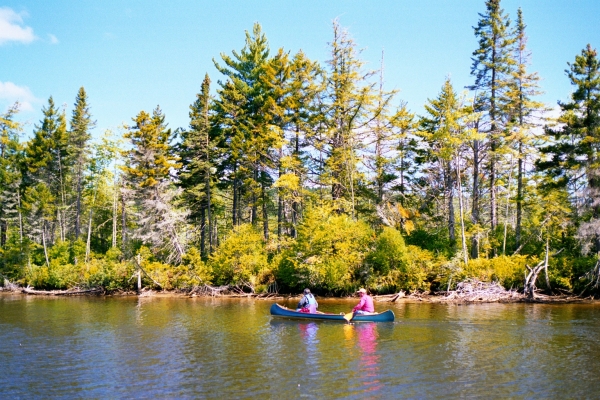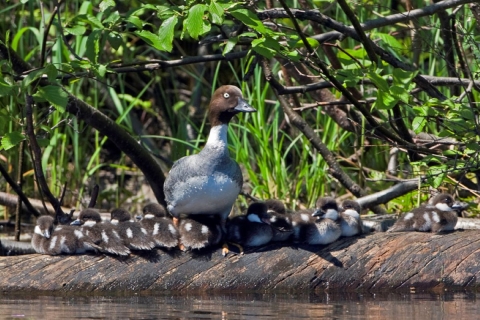
There is ample opportunity to explore Umbagog Lake and the surrounding rivers by canoe, kayak, or other non-motorized watercraft. Whether your interests are wildlife photography, fall foliage, moose-watching, listening to the songs of neotropical migrants, viewing the bald eagles and osprey, enjoying the antics of waterfowl broods, or simply discovering what's around the next bend, an expedition on these northern waterways is an ideal way to experience the refuge and its wildlife.
Please respect wildlife!
Contrary to what many people might expect, canoeists and kayakers can easily disturb and harm the wildlife on the lake. Canoes and kayaks have the ability to go into the far reaches of coves and backwaters and ride close to the shore. Loons and many species of waterfowl, as well as eagles and osprey use these areas for breeding and nesting. Canoeists and kayakers paddling close to nesting birds can flush the birds away from their nests. Flushing birds from nests leaves their eggs or young unprotected, and vulnerable to predation. Repeated disturbances can cause adults to abandon their nests and eggs all together.
Lake Umbagog hosts a large number of waterfowl, including American black ducks, ring-necked ducks, hooded mergansers, common mergansers, common goldeneye and one of the highest concentrations of nesting loons in the state of New Hampshire. Three pairs of bald eagles, as well as many osprey also nest on the refuge. Part of what makes Lake Umbagog special are these birds and the habitats (coves, backwaters and marshes) that they live in. Please help keep these areas as undisturbed as possible during the nesting and breeding season.
When canoeing or kayaking during the nesting and breeding season (April - July):
- stay out in the center of river channels and don't hug the shoreline
- do not paddle into the backs of coves
- if you see any signs of disturbed birds, retreat
- stay out of nesting areas protected with signs
In general, Umbagog National Wildlife Refuge asks that you use caution when observing all wildlife. Keep a respectful distance from any wildlife. If the wildlife you are viewing changes behavior or becomes disturbed, leave the area. Distress signals of loons are tremolo calls (sounds a little like laughing), running across the water, or a "square" brow.
Selected Day and Partial Trips
View the document below to see several options for half-day long paddling trips. Information for each route includes estimated distances, depending on adherence to the shoreline and exploration of the waters. Paddlers should be aware that weather in this region can change rapidly. Umbagog is a large and shallow lake that becomes very challenging in moderate to high winds. Be prepared for a wide range of weather conditions, keep a frequent eye to the sky, and avoid large expanses of open water if conditions are questionable or deteriorating.


